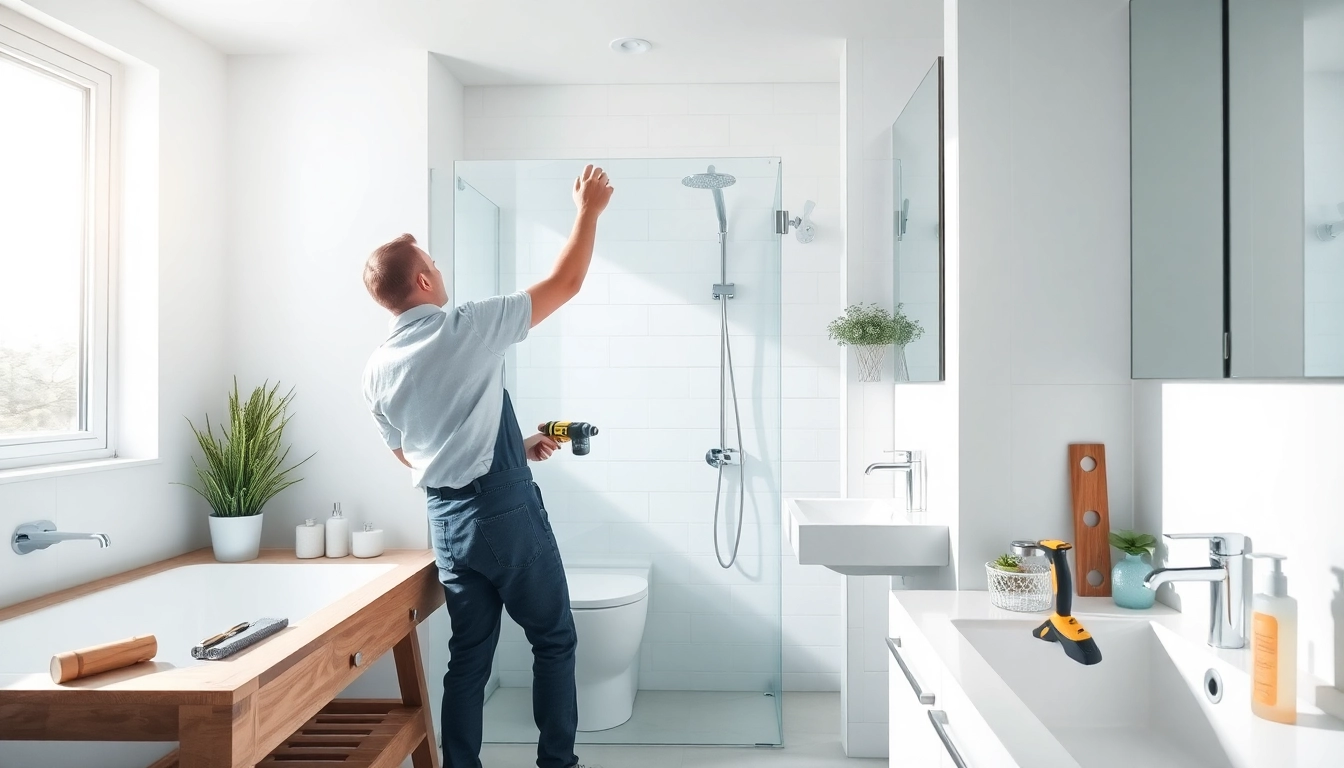Essential Bathroom Fitters: The Ultimate Guide to Renovation in 2025

Understanding the Role of Bathroom Fitters
What Do Bathroom Fitters Do?
Bathroom fitters are specialized professionals responsible for assembling and installing various bathroom components to create a functional and aesthetically pleasing space. Their work encompasses a wide range of tasks, making them essential for both bathroom renovations and new construction projects. Typically, their role includes:
- Installing fixtures such as toilets, sinks, bathtubs, and showers.
- Plumbing work, including routing water supply lines and connecting drainage systems.
- Tile setting and wall finishes, ensuring water resistance and durability.
- Installing bathroom accessories like towel racks, mirrors, and cabinets.
- Ensuring compliance with building codes and safety standards.
Understanding the intricacies involved, from plumbing to design, helps homeowners recognize the value of hiring Bathroom Fitters.
Why Hire Professional Bathroom Fitters?
Entrusting your bathroom renovation or installation to professional bathroom fitters offers several advantages:
- Expertise and Experience: Experienced fitters have honed their skills through various projects, ensuring a high level of craftsmanship that DIY enthusiasts often lack.
- Time Efficiency: Professionals work quickly and efficiently, often completing projects in a fraction of the time it would take an amateur.
- Coding Knowledge: Skilled fitters understand local building codes and regulations, reducing the risk of fines or costly rework.
- Quality Assurance: Many bathroom fitters offer warranties on their work, providing peace of mind that any future issues will be addressed promptly.
- Design Guidance: Professional fitters can provide valuable advice on design trends, layout optimization, and material selection, enhancing the overall aesthetic and functionality of the space.
Key Qualifications of Skilled Bathroom Fitters
When selecting bathroom fitters, it’s essential to consider their qualifications, which typically include:
- Relevant Certifications: Many fitters hold certifications in plumbing, electrical work, or general construction, indicating formal training.
- Portfolio of Past Work: A skilled fitter can showcase past projects, providing you with a clearer understanding of their capabilities and style.
- References and Reviews: Positive testimonials from previous clients highlight reliability and customer satisfaction.
- Insurance and License: Confirming that the fitter has necessary insurance and licenses protects you from potential liabilities.
Factors Influencing Bathroom Fitting Costs
Breaking Down the Average Costs of Bathroom Renovation
The cost of a bathroom renovation can vary significantly, influenced by various factors:
- Size of the Bathroom: Larger spaces often require more materials and labor, increasing costs.
- Quality of Materials: High-end fixtures and finishes add to the budget but can enhance the overall appearance and longevity.
- Complexity of the Project: Custom designs, rearranging plumbing, or adding features like heated floors may raise expenses.
- Labor Costs: Labor rates differ based on locality and the fitters’ level of experience.
Hidden Costs to Consider When Hiring Bathroom Fitters
Many homeowners overlook potential hidden costs when planning their bathroom renovation, such as:
- Permitting Fees: Depending on local regulations, obtaining the necessary permits can add to the overall expense.
- Unexpected Repairs: If underlying issues like mold or outdated plumbing are discovered, this can lead to additional charges.
- Design Changes: Last-minute design changes can disrupt timelines and increase costs.
How to Create a Budget for Your Bathroom Renovation
Establishing a budget for your renovation is crucial for managing expectations and avoiding financial strain. Here are some steps to ensure a smooth budgeting process:
- Assess Your Current Bathroom: Analyze what is functional and what needs improvement.
- Research Costs: Gather estimates from different bathroom fitters to get a realistic idea of labor and materials costs.
- Prioritize Needs vs. Wants: Determine which elements are essential and which can be postponed if budget constraints arise.
- Set Aside a Contingency Fund: Allocate an additional 10-20% of your budget for unexpected expenses.
Choosing the Right Bathroom Fitters
What to Look for in Bathroom Fitting Services
Finding the right bathroom fitters requires careful consideration. Here are factors to assess when evaluating potential candidates:
- Experience: Look for fitters with substantial experience and a diverse portfolio of past work.
- Reputation: Seek recommendations from friends or family, or consult online reviews and ratings.
- Professionalism: How fitters communicate and present themselves can indicate their overall quality and reliability.
- Customization Options: Choose fitters who offer tailored solutions rather than one-size-fits-all services.
How to Validate Reviews and Testimonials for Bathroom Fitters
Before settling on a bathroom fitter, it’s essential to authenticate their reviews:
- Cross-Reference Reviews: Look at multiple platforms (Yelp, Google Reviews, etc.) to gauge consistency in feedback.
- Contact Past Clients: Reach out to previous customers to inquire about their experience and satisfaction.
- Inspect Completed Projects: If possible, visit finished projects to see the quality of work firsthand.
Questions to Ask Before Hiring Bathroom Fitters
Proper due diligence involves asking the right questions during interviews:
- What is your estimated timeline for completion?
- Can you provide a detailed written estimate outlining all costs?
- What warranties or guarantees do you offer on your work?
- How will you handle unexpected issues that arise during the project?
The Bathroom Remodeling Process with Fitters
From Consultation to Completion: Steps with Bathroom Fitters
The renovation process typically unfolds in several stages, including:
- Initial Consultation: Discuss your vision, budget, and specifications with the fitters.
- Design and Planning: Collaborate on the design, select fixtures, and finalize timelines.
- Preparation: Remove existing fixtures and prepare the space for new installations.
- Installation: Fitters install new components, adhering to best practices and regulations.
- Final Walkthrough: Conduct a final review to ensure all work meets your expectations.
Common Challenges in Bathroom Renovation Projects
Even with careful planning, challenges may arise during a renovation:
- Unexpected Structural Issues: Discovering outdated plumbing or mold can delay progress.
- Material Shortages: Supply chain disruptions can make it difficult to secure specific fixtures or materials.
- Design Conflicts: Balancing personal style with practical considerations may lead to disagreements.
Best Practices for a Smooth Renovation with Bathroom Fitters
Implement these best practices to enhance the likelihood of a successful renovation:
- Maintain Clear Communication: Establish ongoing communication with your fitter to address concerns promptly.
- Set Realistic Expectations: Understand that renovations may not progress exactly as planned, and be flexible.
- Be Prepared for the Unexpected: Accept that surprises may arise, and adjust your budget accordingly.
Evaluating the Success of Your Bathroom Renovation
How to Measure Satisfaction Post-Renovation
After your bathroom renovation, consider the following metrics to gauge success:
- Visual Inspection: Does the final product align with your aesthetic goals?
- Functionality Assessment: Are all fixtures working correctly and comfortably?
- Budget Review: Did the project stay within the projected budget?
Key Metrics for Bathroom Fitting Success
Evaluating success goes beyond aesthetics; consider the following metrics:
- Customer Satisfaction Ratings: Post-project surveys can yield valuable feedback.
- Duration Comparison: Was the project completed within the estimated timeline?
- Cost Tracking: Analyze whether the final costs aligned with the initial estimates.
Maintaining Your Newly Fitted Bathroom
To prolong the life and functionality of your renovated bathroom, consider these maintenance tips:
- Regularly check for leaks and water damage.
- Clean fixtures with appropriate products to prevent buildup and wear.
- Schedule periodic inspections to ensure everything is functioning optimally.






